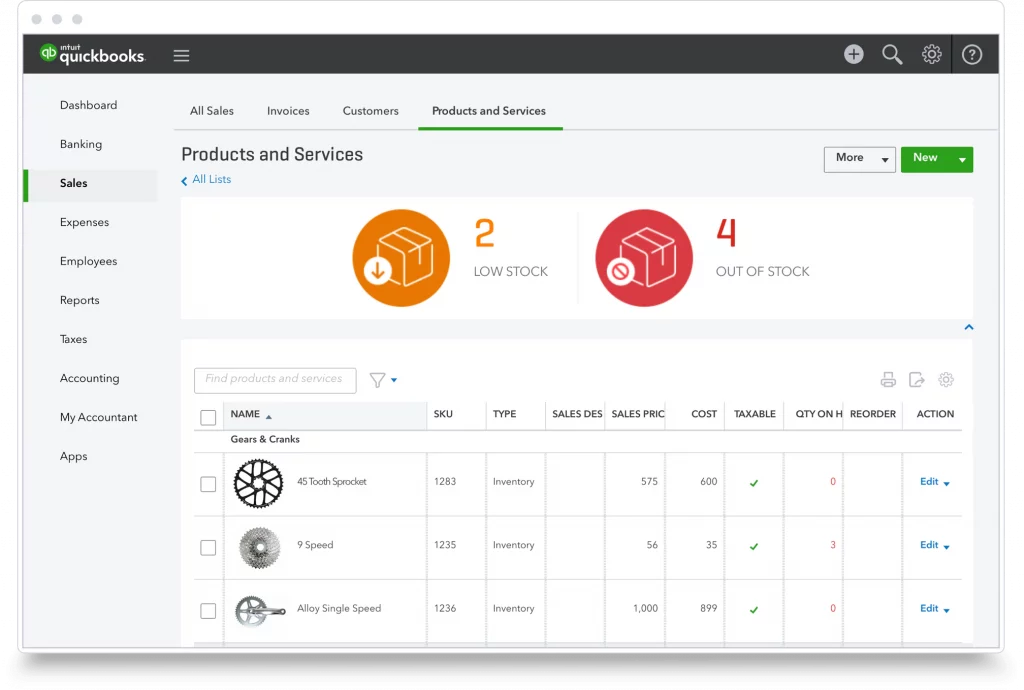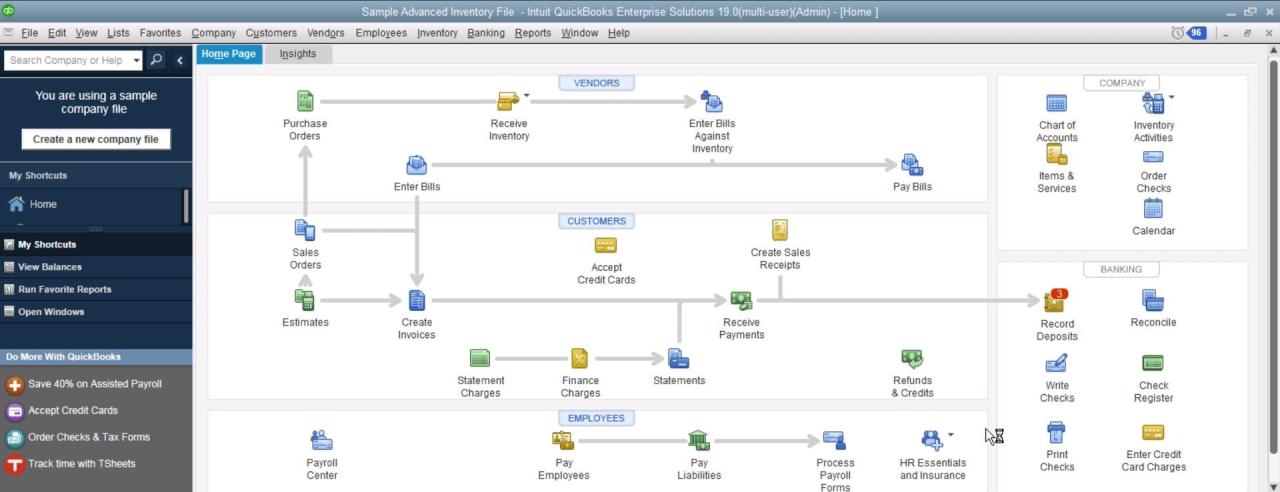
Unlocking Efficiency: A Comprehensive Guide to Business Inventory Management with QuickBooks Enterprise
In today’s dynamic business landscape, efficient inventory management is no longer just a best practice; it’s a critical determinant of success, profitability, and customer satisfaction. Businesses, from burgeoning startups to established enterprises, grapple with the delicate balance of having enough stock to meet demand without incurring the costs of overstocking or the pitfalls of stockouts. For many, navigating this complexity requires a robust, integrated solution. This is where QuickBooks Enterprise steps in, offering a powerful suite of tools specifically designed to streamline and optimize business inventory management.
This comprehensive guide will delve into how QuickBooks Enterprise empowers businesses to master their inventory, transforming what can often be a chaotic process into a strategic advantage.
The Critical Role of Inventory Management
Before exploring the "how," it’s crucial to understand the "why." Poor inventory management can lead to a cascade of problems:
- Lost Sales & Customer Dissatisfaction: Stockouts mean missed opportunities and unhappy customers who might turn to competitors.
- Increased Holding Costs: Overstocking ties up capital, incurs storage costs (warehousing, insurance, utilities), and increases the risk of obsolescence or damage.
- Reduced Cash Flow: Money tied up in excess inventory is money that can’t be invested elsewhere in the business.
- Inefficiency & Waste: Manual tracking leads to errors, wasted time, and inefficient processes.
- Inaccurate Financial Reporting: Incorrect inventory valuation directly impacts the balance sheet and income statement, leading to poor strategic decisions.
QuickBooks Enterprise directly addresses these challenges by providing a centralized, automated system that offers real-time visibility and control.
QuickBooks Enterprise: A Robust Solution for Inventory
QuickBooks Enterprise is Intuit’s most powerful accounting software, specifically built for growing small and mid-sized businesses that have outgrown QuickBooks Pro or Premier. Its advanced features extend far beyond basic accounting, offering sophisticated capabilities crucial for complex inventory needs.
Key Differentiators for Inventory Management in QBE:
- Scalability: Handles millions of items and thousands of vendors/customers, accommodating significant business growth.
- Advanced Inventory Module: This optional, but highly recommended, add-on unlocks the most powerful inventory features, making QBE a true inventory management system.
- Multi-User Access: Supports up to 40 concurrent users, ensuring all relevant departments (sales, purchasing, warehouse) can access and update inventory data in real-time.
- Customization: Offers extensive customization options for reports, forms, and user roles, tailoring the system to specific business workflows.
Core Inventory Management Features in QuickBooks Enterprise: The "How-To"
Let’s break down the practical application of QuickBooks Enterprise’s inventory features.
1. Item Setup and Detailed Tracking
How it works:
At the heart of QBE’s inventory system is the "Item List." Businesses begin by meticulously setting up each inventory item. This isn’t just about a name; it’s about a comprehensive data profile.
- Creating Items: Users can define various item types:
- Inventory Part: For items bought, tracked, and sold.
- Inventory Assembly: For items built from other inventory parts (Bill of Materials).
- Non-Inventory Part: For items bought and sold but not tracked in inventory (e.g., specific services or direct-ship items).
- Service: For services rendered.
- Detailed Information: For each inventory item, businesses input:
- SKU (Stock Keeping Unit): A unique identifier.
- Description: Clear and concise product details.
- Preferred Vendor: Streamlines purchasing.
- Cost of Goods Sold (COGS) Account: Links to accounting.
- Sales Price & Income Account: For revenue tracking.
- Asset Account: Where inventory value is held on the balance sheet.
- Units of Measure: Define how items are bought (e.g., by the case) and sold (e.g., individually), allowing for seamless conversion.
- Reorder Points: Set minimum quantities to trigger alerts when stock is low, preventing stockouts.
Benefit: This granular setup ensures accurate data from the start, providing a single source of truth for every product, crucial for both operational efficiency and financial reporting.
2. Advanced Inventory Module (A Game Changer)
The Advanced Inventory module in QuickBooks Enterprise elevates inventory management to a professional level.
-
Multi-Location Inventory Tracking:
- How it works: Businesses can track inventory quantities and values across multiple warehouses, retail stores, service trucks, or consignment locations. When creating an item, you can assign it to specific sites. Purchase orders and sales orders then specify the relevant location. Transfers between locations are also easily managed, adjusting quantities at each site.
- Benefit: Provides a holistic view of stock levels across the entire operation, optimizing fulfillment, reducing transfer costs, and improving stock rotation.
-
Serial Number or Lot Number Tracking:
- How it works: For businesses dealing with products that require individual tracking (e.g., electronics, machinery) or batch tracking (e.g., food, pharmaceuticals), QBE allows assignment of unique serial numbers or lot numbers upon receipt and tracks them through sales. This is critical for warranties, recalls, and quality control.
- Benefit: Enhances traceability, enables targeted recalls, improves customer service, and ensures compliance with industry regulations.
-
Barcoding:
- How it works: QBE integrates with barcode scanners. Businesses can print their own barcodes or use existing manufacturer codes. During receiving, picking, packing, and sales, employees simply scan items, automatically updating inventory quantities in real-time.
- Benefit: Significantly increases accuracy and speed of inventory counts, order fulfillment, and receiving, while drastically reducing manual data entry errors.
-
FIFO (First-In, First-Out) Costing (Specific to QBE Platinum and Diamond):
- How it works: While standard QBE uses Average Costing, Platinum and Diamond subscriptions offer FIFO costing. This method assumes that the first units purchased are the first ones sold, providing a more accurate representation of the cost of goods sold, especially in periods of fluctuating prices.
- Benefit: Provides a more precise valuation of inventory and COGS, which can have significant implications for tax and financial reporting.
3. Purchasing and Receiving
How it works:
QBE streamlines the entire procurement process, from identifying needs to receiving goods.
- Purchase Orders (POs): Generated based on reorder points or manual entry. POs specify vendor, items, quantities, prices, and desired delivery dates.
- Receiving Inventory: When goods arrive, users "Receive Items" against a PO, automatically increasing inventory quantities and creating an "Item Receipt."
- Entering Bills: Once the vendor bill arrives, it’s matched against the Item Receipt, completing the purchase cycle and impacting accounts payable.
Benefit: Automates purchasing, reduces errors, improves vendor management, and provides a clear audit trail for every transaction.
4. Sales and Order Fulfillment
How it works:
QBE ensures a smooth flow from customer order to delivery.
- Sales Orders: Capture customer commitments for future deliveries, reserving inventory without immediately impacting stock levels or invoicing.
- Invoicing: When items are shipped, the sales order can be converted into an invoice, automatically decreasing inventory quantities and impacting accounts receivable.
- Picking & Packing Workflows: The system can generate picking lists based on sales orders, guiding warehouse staff to efficiently gather items, especially useful with multi-location tracking.
Benefit: Accelerates order processing, minimizes shipping errors, and provides real-time updates on available inventory, enhancing customer service.
5. Inventory Adjustments and Transfers
How it works:
Maintaining inventory accuracy often requires adjustments.
- Inventory Adjustments: Used to correct discrepancies found during physical counts, account for damaged goods, or adjust value due to obsolescence. Users can specify the adjustment account (e.g., Inventory Shrinkage).
- Inventory Transfers: With multi-location tracking, items can be seamlessly moved between sites, updating quantities at both the sending and receiving locations.
Benefit: Keeps inventory records accurate, preventing financial discrepancies and ensuring reliable stock levels for sales.
6. Assembly and Manufacturing
How it works:
For businesses that assemble products from components, QBE’s "Inventory Assembly" feature is invaluable.
- Bill of Materials (BOM): Define the list of component parts (sub-assemblies, raw materials) required to build a finished product.
- Build Assemblies: When a finished product is assembled, QBE automatically decreases the quantity of component parts and increases the quantity of the finished assembly.
Benefit: Simplifies the manufacturing process, accurately tracks components, and provides a clear picture of costs associated with finished goods.
Leveraging Reports for Strategic Decision-Making
QuickBooks Enterprise’s reporting capabilities are crucial for transforming raw data into actionable insights.
- Inventory Stock Status by Item: Shows current quantity on hand, on order, and on sales order.
- Inventory Valuation Summary/Detail: Provides the total value of inventory, breaking it down by item, location, or even lot/serial number.
- Sales by Item Summary/Detail: Identifies best-selling and slow-moving products.
- Inventory Reorder Point Report: Flags items that are below their reorder point, prompting timely purchases.
- Adjusted Inventory Worksheet: Helps reconcile physical counts with system records.
How to use them:
These reports empower businesses to:
- Optimize Reordering: Prevent stockouts and overstocking by ordering at the right time.
- Identify Trends: Understand product popularity, seasonality, and customer preferences.
- Improve Cash Flow: Reduce capital tied up in slow-moving or obsolete inventory.
- Make Informed Pricing Decisions: Understand true costs and profitability per item.
- Enhance Forecasting: Better predict future demand based on historical data.
Best Practices for Effective Inventory Management with QBE
To maximize the benefits of QuickBooks Enterprise, consider these best practices:
- Conduct Regular Physical Counts/Cycle Counts: Even with a robust system, periodic physical verification is essential to catch discrepancies and maintain accuracy.
- Set Accurate Reorder Points: Continuously review and adjust reorder points based on sales velocity, lead times, and supplier reliability.
- Train Your Team Thoroughly: Ensure all staff involved in inventory (purchasing, receiving, sales, warehouse) are proficient in using QBE’s features correctly.
- Utilize Barcoding: Implement barcoding for all inventory transactions to enhance speed and accuracy.
- Leverage Multi-Location Tracking: If you have multiple storage sites, fully utilize this feature for comprehensive visibility.
- Regularly Review Reports: Make it a habit to analyze inventory reports to identify trends, inefficiencies, and opportunities.
- Maintain Clean Data: Regularly review item lists, remove obsolete items, and correct any data entry errors.
Conclusion
QuickBooks Enterprise is more than just an accounting package; it’s a powerful, scalable, and comprehensive solution for businesses seeking to master their inventory. By leveraging its advanced features – from multi-location tracking and barcoding to detailed item setup and robust reporting – businesses can transform their inventory management from a source of stress into a strategic asset.
Implementing QuickBooks Enterprise for inventory management means gaining unparalleled visibility, improving operational efficiency, reducing costs, and ultimately, boosting profitability. In an increasingly competitive market, the ability to effectively manage inventory is not just an advantage; it’s a necessity for sustainable growth and success.

